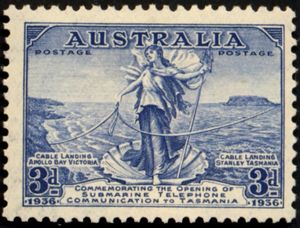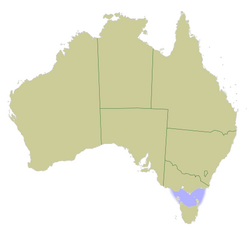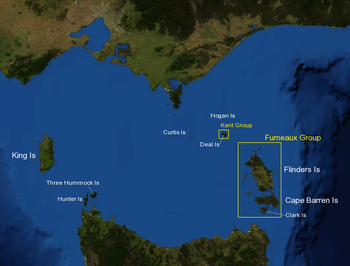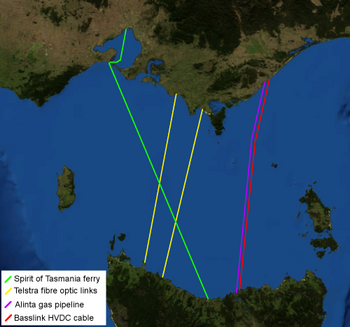Bass Strait
Bass Strait (pronounced /ˈbæs/) is a sea strait separating Tasmania from the south of the Australian mainland, specifically the state of Victoria.
Contents
Extent
The International Hydrographic Organization defines the limits of the Bass Strait as follows:[1]
On the West. The Eastern limit of the Great Australian Bight [A line from Cape Otway, Australia, to King Island and thence to Cape Grim, the Northwest extreme of Tasmania].
On the East. The Western limit of the Tasman Sea between Gabo Island and Eddystone Point [A line from Gabo Island (near Cape Howe, 37°30'S) to the Northeast point of East Sister Island (148°E) thence along the 148th meridian to Flinders Island; beyond this Island a line running to the Eastward of the Vansittart Shoals to [Cape] Barren Island, and from Cape Barren (the Easternmost point of [Cape] Barren Island) to Eddystone Point (41°S) in Tasmania].
Discovery and exploration
The strait was named after George Bass in 1800, after he and Matthew Flinders passed through it while circumnavigating Tasmania in the Norfolk in 1798–99. Governor Hunter subsequently named the stretch of water between the mainland and Van Diemen's Land (at Flinders' recommendations) "Basses Strait". Later it became known as Bass Strait.[2]
The existence of the strait had already been suggested by the master of the Sydney Cove when he reached Sydney (after he grounded his ship and being stranded) on Preservation Island. He reported that the strong south westerly swell and the tides and currents suggested that the island was in a channel linking the Pacific and southern Indian Ocean. The Governor of New South Wales, John Hunter thus wrote to Joseph Banks in August 1797 that it seemed certain the strait existed.[3]
Conditions
Approximately 240 km wide at its narrowest point and generally around 50 metres deep, it contains many islands, with King Island and Flinders Island home to substantial human settlements.
Like the rest of the waters surrounding Tasmania, and particularly because of its limited depth, it is notoriously rough, with many ships lost there during the 19th century. A lighthouse was erected on Deal Island in 1848 to assist ships in the eastern part of the Straits, but there were no guides to the western entrance until the Wilsons Promontory Lighthouse was completed in 1859, followed by another at Cape Wickham at the northern end of King Island in 1861.
Maritime history
Strong currents between the Antarctic-driven southeast portions of the Indian Ocean and the Tasman Sea's Pacific Ocean waters provide a strait of powerful, wild storm waves. To illustrate its wild strength, Bass Strait is both twice as wide and twice as rough as the English Channel. The shipwrecks on the Tasmanian and Victorian coastlines number in the hundreds, although stronger metal ships and modern marine navigation have dropped the danger sharply.
Many vessels, some quite large, have disappeared without trace, or left scant evidence of their passing. Despite myths and legends of piracy, wrecking and alleged supernatural phenomena akin to those of the Bermuda Triangle, such disappearances can be invariably ascribed to treacherous combinations of wind and sea conditions, and the numerous semi-submerged rocks and reefs within the Straits.[4]
Despite the strait's difficult waters it provided a safer and less boisterous passage for ships on the route from Europe or India to Sydney in the early 19th century. The strait also saved 700 miles distance on the voyage.[3]
Islands
There are over 50 islands in Bass Strait. Major islands include:
Western section:
South eastern section:
- Furneaux Group
- Flinders Island
- Cape Barren Island
- Clark Island
- and over 60 other islands
North eastern section:
- Kent Group
- Deal Island
- and 3 smaller islands
- Hogan Island
- Curtis Island
Natural resources
- See also: Energy in Victoria
A number of oil and gas fields exist in Bass Strait. The eastern field, known as the Gippsland Basin, was discovered in the 1960s and is located about 50 km off the coast of Gippsland. The oil and gas is sent via a pipeline to gas processing facilities and oil refineries at Longford, Western Port, Altona and Geelong, as well as by tanker to New South Wales. The western field, known as the Otway Basin, was discovered in the 1990s offshore near Port Campbell. Its exploitation began in 2005.
Infrastructure
Transport
The fastest and cheapest method of travel across Bass Strait is by air. The main carriers are Qantas, JetStar, and Virgin Blue. Major airports include the Hobart International Airport and Launceston Airport; the smaller airports are serviced by Regional Express which generally flies only to Melbourne and the Bass Strait islands.
The domestic sea route is serviced by two Spirit of Tasmania passenger vehicle ferries, based in Devonport, Tasmania. The ships travel daily in opposite directions between Devonport and Station Pier in Melbourne, as overnight trips with additional daytime trips during the peak summer season.
See Transportation in Tasmania for more details.
Energy
- See also: Basslink
The Basslink HVDC electrical cable has been in service since 2006. It has the capacity to carry up to 630 Megawatts of electrical power across the strait.
Alinta owns a submarine gas pipeline, delivering natural gas to large industrial customers near George Town, as well as the Powerco gas network in Tasmania.
Communications

The first submarine communications cable across Bass Strait was laid in 1859. Starting at Cape Otway, Victoria, it went via King Island and Three Hummock Island, made contact with the Tasmanian mainland at Stanley Head, and then continued on to George Town. However it started failing within a few weeks of completion, and by 1861 it failed completely.
Tasmania is currently connected to the mainland via two Telstra-operated fibre optic cables; since 2006, dark fibre capacity has also been available on the Basslink HVDC cable.
Other submarine cables include:
| Date | Northern end | Southern end | Companies (Manufacturer / Operator) |
Details |
|---|---|---|---|---|
| 1859–1861 | Cape Otway | Stanley Head | Henley's Telegraph Works Tas & Vic Govts |
System 140 nm |
| 1869-? | ? | ? | Henley's Telegraph Works Australian Govt |
System 176 nm |
| 1885-? | ? | ? | Telcon Australian Government |
|
| 1909–1943 | ? | ? | Siemens Bros Australian Government |
System 285 nm. Was reused at Torres Strait |
| 1936 | Apollo Bay | Stanley | Siemens Bros Australian Government |
First telephone cable, failed after only six months[5] |
| 1995- | Sandy Point | Boat Harbour | ASN Telstra |
First fibre optic cable |
| 2003- | Inverloch | Stanley | ASN Calais Telstra |
|
| 2005- | Loy Yang | Bell Bay | Basslink | First electrical distribution cable |
Popular culture
- See also Bass Strait Triangle
The issue of planes, and ships and people being lost in the Strait over time has caused a number of theories about the reasons. Perhaps the most thorough list of losses and disappearances has been the oft re-printed book of Jack Loney [6] however it is possible that most losses can be adequately explained by extreme weather events.[7]
On the popular Australian soap Neighbours, one of its most dramatic storylines unfolded when a 1940s themed joy flight to Tasmania was sabotaged by a bomb. The plane crashed into Bass Strait in the middle of the night and many character's lives were put at risk, with some drowning.
In 1978, one of the most famous UFO incidents in Australian history occurred over Bass Strait. Frederick Valentich was flying a small aeroplane over the strait when he reported to personnel at a local airport that a strange object was buzzing his plane. He then claimed that the object had moved directly in front of his plane; the airport personnel then heard a metallic "scraping" sound, followed by silence. Valentich and his plane subsequently vanished and neither Valentich nor his plane were ever seen again.
Crossings
Non-motorised crossings are regularly attempted across the strait.
Australian Olympic Bronze Medallist Michael Blackburn sailed a Laser Sailboat across the strait in October 2005.[8]
This crossing is also made semi-regularly by experienced sea kayakers, usually by island hopping on the Eastern side of the strait.[9][10][11]
The first windsurfer crossing was in 1982 by Mark Paul and Les Tokolyi.[12] Kite boarders also do the crossing.[13]
References
- ↑ "Limits of Oceans and Seas, 3rd edition". International Hydrographic Organization. 1953. http://www.iho-ohi.net/iho_pubs/standard/S-23/S23_1953.pdf. Retrieved 7 February 2010.
- ↑ Flinders, Matthew (1814). A Voyage to Terra Australis
- ↑ 3.0 3.1 Blainey, Geoffrey (1966). Tyranny of Distance: How Distance Shaped Australia's History. Melbourne: Sun Books. pp. 73–4.
- ↑ See section below Popular Culture and also Bass Strait Triangle for further detail
- ↑ "Apollo Bay Submarine Cable Repeater Station". Register of the National Estate. www.aussieheritage.com.au. http://www.aussieheritage.com.au/listings/vic/Apollo%20Bay/ApolloBaySubmarineCableRepeaterStation/14576. Retrieved 2008-08-13.
- ↑ Jack Loney, Mysteries of the Bass Strait Triangle, Neptune Press, 1st ed. 1980. 3rd ed. 1984 5th ed. 1993 (ISBN 0-9091315-3-8) and later editions
- ↑ Spirit of Tasmania I section regarding 2005 event asa good example
- ↑ http://www.shortypen.com/brdboat/cruise/blkburn/
- ↑ http://www.breakloose.com.au/articles/idx/6/035/article/Bass_Strait_Crossing_by_sea_kayak.html
- ↑ http://www.paddlewithsim.com/node/67
- ↑ http://www.nswseakayaker.asn.au/mag/38/bassstraitsolo.html
- ↑ The Sun May 5th, 1982[Full citation needed]
- ↑ http://www.abc.net.au/news/stories/2009/09/02/2674167.htm
External links
- Tasmanian Department of State Development - Redi Map
- "Telstra plans second Bass Strait optical fibre cable". Sydney Morning Herald. 2 August 2002. http://www.smh.com.au/articles/2002/08/02/1028157835668.html.
- "The Basslink Project". National Grid. http://www.nationalgrid.com.au/document.php?objectID=102.
- "History of the Atlantic Cable & Undersea Communications". http://www.atlantic-cable.com/Cables/CableTimeLine/index.htm.
Further reading
- Broxam and Nash, Tasmanian Shipwrecks, Volumes I and II, Navarine Publishing, Canberra, 1998 & 2000.
| ||||||||||||||
Coordinates: 39°56′09″S 146°04′52″E / 39.93583°S 146.08111°E
ar:باس (مضيق) ca:Estret de Bass cs:Bassův průliv da:Bassstrædet de:Bass-Straße et:Bassi väin es:Estrecho de Bass eu:Bass itsasartea fa:تنگه باس fr:Détroit de Bass gl:Estreito de Bass ko:배스 해협 hi:बॉस जलसन्धि id:Selat Bass ia:Stricto de Bass it:Stretto di Bass he:מצר בס ku:Tengava Bass lt:Baso sąsiauris hu:Bass-szoros ms:Selat Bass nl:Straat Bass ja:バス海峡 no:Bass-stredet pl:Cieśnina Bassa pt:Estreito de Bass ro:Strâmtoarea Bass ru:Бассов пролив sk:Bassov prieliv fi:Bassinsalmi sv:Bass-sundet ta:பாஸ் நீரிணை uk:Бассова протока war:Estrecho han Bass zh:巴斯海峡



